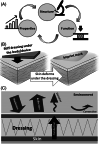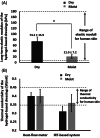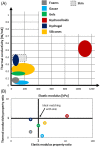Alternatives and preferences for materials in use for pressure ulcer prevention: An experiment-reinforced literature review
- PMID: 35274443
- PMCID: PMC9615286
- DOI: 10.1111/iwj.13784
Alternatives and preferences for materials in use for pressure ulcer prevention: An experiment-reinforced literature review
Abstract
Alleviation of localised, sustained tissue loads and microclimate management are the most critical performance criteria for materials in use for pressure ulcer prevention, such as in prophylactic dressings, padding or cushioning. These material performance criteria can be evaluated by calculating the extents of matching between the material stiffness (elastic modulus) and the thermal conductivity of the protective dressing, padding or cushioning with the corresponding properties of native skin, separately or in combination. Based on these bioengineering performance criteria, hydrocolloids, which are commonly used for prophylaxis of medical device-related pressure ulcers, exhibit poor stiffness matching with skin. In addition, there is remarkable variability in the modulus and thermal conductivity matching levels of different material types used for pressure ulcer prevention, however, it appears that among the materials tested, hydrogels provide the optimal matching with skin, followed by gels and silicone foams. The stiffness matching for hydrocolloids appears to be inferior even to that of gauze. This article provides quantitative performance criteria and metrics for these evaluations, and grades commonly used material types to biomechanically guide clinicians and industry with regards to the selection of dressings for pressure ulcer prevention, both due to bodyweight forces and as a result of applied medical devices.
Keywords: biomechanical properties; laboratory testing; padding and cushioning; pressure injury; prophylactic dressings.
© 2022 The Author. International Wound Journal published by Medicalhelplines.com Inc (3M) and John Wiley & Sons Ltd.
Figures




Similar articles
-
The frictional energy absorber effectiveness and its impact on the pressure ulcer prevention performance of multilayer dressings.Int Wound J. 2024 Apr;21(4):e14871. doi: 10.1111/iwj.14871. Int Wound J. 2024. PMID: 38591160 Free PMC article. Review.
-
Pressure ulcer prevention dressing design and biomechanical efficacy.J Wound Care. 2020 Dec 1;29(Sup12):S6-S15. doi: 10.12968/jowc.2020.29.Sup12.S6. J Wound Care. 2020. PMID: 33320759
-
What makes a hydrogel-based dressing advantageous for the prevention of medical device-related pressure ulcers.Int Wound J. 2022 Mar;19(3):515-530. doi: 10.1111/iwj.13650. Epub 2021 Jul 10. Int Wound J. 2022. PMID: 34245120 Free PMC article.
-
The biomechanical efficacy of a hydrogel-based dressing in preventing facial medical device-related pressure ulcers.Int Wound J. 2022 Aug;19(5):1051-1063. doi: 10.1111/iwj.13701. Epub 2021 Oct 8. Int Wound J. 2022. PMID: 34623741 Free PMC article.
-
Dressings for preventing pressure ulcers: how do they work?J Wound Care. 2021 Jan 2;30(1):33-39. doi: 10.12968/jowc.2021.30.1.33. J Wound Care. 2021. PMID: 33439083 Review.
Cited by
-
The frictional energy absorber effectiveness and its impact on the pressure ulcer prevention performance of multilayer dressings.Int Wound J. 2024 Apr;21(4):e14871. doi: 10.1111/iwj.14871. Int Wound J. 2024. PMID: 38591160 Free PMC article. Review.
-
Impact of hydrocolloid dressings in the prevention of pressure ulcers in high-risk patients: a randomized controlled trial (PENFUP).Sci Rep. 2023 Dec 7;13(1):21639. doi: 10.1038/s41598-023-47483-0. Sci Rep. 2023. PMID: 38062132 Free PMC article. Clinical Trial.
-
Application of the Jigsaw Puzzle Flap Based on Freestyle Perforators to Repair Large and Deep Ulcers on the Buttocks.Front Surg. 2022 Apr 13;9:739250. doi: 10.3389/fsurg.2022.739250. eCollection 2022. Front Surg. 2022. PMID: 35495744 Free PMC article.
-
Strategies in surface engineering for the regulation of microclimates in skin-medical product interactions.Heliyon. 2024 Feb 1;10(4):e25395. doi: 10.1016/j.heliyon.2024.e25395. eCollection 2024 Feb 29. Heliyon. 2024. PMID: 38370189 Free PMC article. Review.
-
The effect of micro-movement on prevention of intraoperative acquired pressure injury in overweight patients undergoing posterior lumbar surgery: a randomized controlled trial.J Orthop Surg Res. 2024 Dec 4;19(1):823. doi: 10.1186/s13018-024-05312-8. J Orthop Surg Res. 2024. PMID: 39633469 Free PMC article. Clinical Trial.
References
-
- Brown G. Long‐term outcomes of full‐thickness pressure ulcers: healing and mortality. Ostomy Wound Manage. 2003;49(10):42‐50. - PubMed
-
- Redelings MD, Lee NE, Sorvillo F. Pressure ulcers: more lethal than we thought? Adv Skin Wound Care. 2005;18(7):367‐372. - PubMed
-
- Khor HM, Tan J, Saedon NI, et al. Determinants of mortality among older adults with pressure ulcers. Arch Gerontol Geriatr. 2014;59(3):536‐541. - PubMed
-
- Agency for Healthcare Research & Quality . Preventing Pressure Ulcers in Hospitals. Rockville, MD, USA: US Agency for Healthcare Research and Quality; 2014. https://www.ahrq.gov/patient-safety/settings/hospital/resource/pressureu..., .
MeSH terms
Substances
Grants and funding
LinkOut - more resources
Full Text Sources
Medical

